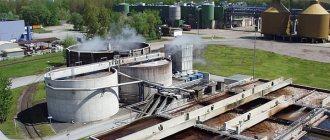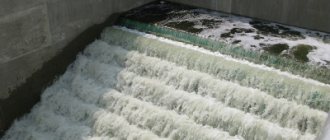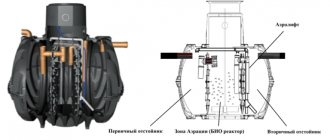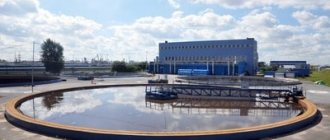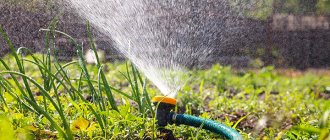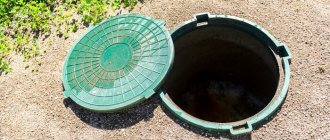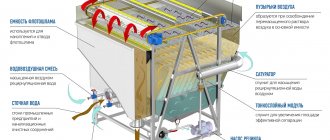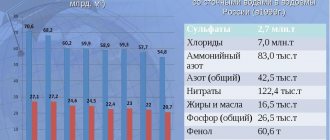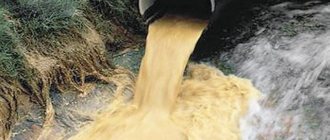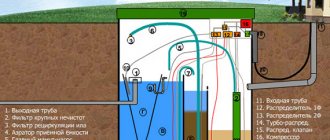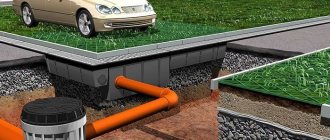Wastewater treatment is the removal of foreign impurities from it before discharge into a body of water or soil. Wastewater can be divided into several categories:
- household – sewerage;
- industrial - the result of the work of factories and factories;
- atmospheric - melt and rain water.
Not only wastewater discharged by enterprises must be treated, but also household wastewater from sewer systems. Poorly treated water from even a small private home can cause serious damage to the environment.
Previously, sewage was collected in ordinary, so-called cesspools, but due to non-compliance with sanitary standards, they had to be abandoned. Today, autonomous treatment facilities are used to collect and treat household wastewater, where it is purified by 90 - 99%. After which they can be dumped into open water bodies or soil.
Stages of wastewater treatment
All processes of the sewage treatment plant system can be divided into the following stages:
- mechanical cleaning;
- averaging (primary settling tank);
- anaerobic stage;
- aerobic stage;
- nitrification stage;
- secondary settling;
- tertiary treatment stage;
- disinfection stage.
Mechanical cleaning
Wastewater flows through a common gravity collector into a receiving chamber in which stations are installed to retain coarse impurities larger than 6 mm in size. Coarse solid waste (garbage, paper, etc.) from a lattice container is manually unloaded into plastic bags, which are then transported by special transport from the territory of the domestic wastewater treatment plant. This procedure can be carried out using the following equipment:
- mechanical gratings;
- drum sieves;
- sand traps (sand traps);
- grease traps.
Also, if there is a large amount of petroleum products and fat-containing impurities in the local sewage system, a flotator can be installed, which will serve as an additional pre-treatment stage.
Averaging
Wastewater cleared of debris enters the homogenizer, which is designed to average the wastewater in terms of composition and flow rate. The homogenizer is equipped with mixers (see catalog) and systems for supplying wastewater to biological treatment. A mixing system using a pump prevents sedimentation of suspended particles and ensures averaging of wastewater by composition. The intensity is changed using a slider.
Anaerobic stage
With the help of PNP feed pumps, wastewater from the homogenizer is uniformly supplied at an average hourly flow rate to the denitrifier, which is equipped with a modern hydraulic system for homogenization, consisting of a PND submersible pump, a pressure manifold and drop pipelines with nozzles at the end. At this stage, nitrates are removed. Excess sludge from the denitrifier is periodically pumped out using a pumping station into a sludge storage tank.
Aerobic stage
In the first stage aeration tank, a highly loaded biological treatment process is carried out, in which, thanks to microorganisms and oxygen, the majority of existing organic substances are oxidized. Aeration, as well as mixing of the sludge substance in the aeration tank, is carried out using tubular fine-bubble aerators of the “Polypore” type; the intensity is adjusted using valves.
Denitrification and nitrification stage
From the aeration tank, through a gap in the lower part of the partition, wastewater flows independently into the nitrifier, where the second stage of biological treatment is implemented with the nitrification procedure (the transition of ammonium nitrogen into nitrates). To intensify and stabilize the process, an inert loading of the “Framework” type is used, on which microflora is fixed in the form of a biofilm. The process of aeration, washing of the load and mixing in the nitrifier occurs due to the work of tubular aerators. The intensity of the aeration unit is regulated by valves.
Secondary settling
After the nitrifier, the sludge mixture enters the secondary settling tank, where sludge sedimentation occurs. The flow rate of the recycle sludge mixture is regulated depending on the concentration of pollutants in the source sewer water. Abundant sludge from secondary settling tanks is periodically, based on the measurement results, pumped out using airlifts into a sludge storage tank.
Post-treatment stage
As a rule, having gone through these previous stages, wastewater does not have the necessary degree of purification that meets the requirements for discharge into fishery waters, so additional purification is required. This is done using microfilters that contain various absorbent elements, for example, active carbon. The clarified sewage runoff from the surface of the secondary settling tank passes through perforated pipes into a collection tray, from where it enters the above-filter space of the filter with a floating load through a weir. At the same time, constant aeration of the load is carried out using an aerator. From the above-filter space, wastewater is directed to the adsorber, where a carbon filter is used. This adsorber ensures effective removal of high and low molecular weight organic substances from water.
Disinfection stage
The purified water flows by gravity into the clean water compartment. Compressed air is supplied to the tank through the aerator by a turbo blower to saturate the water with oxygen. From the reservoir, purified water enters the bactericidal installation for ultraviolet disinfection of the treatment unit and then through the meter-flow meter RS1 to outlet. This equipment is used to destroy bacteria by ultraviolet irradiation, as well as ultrasound. The advantage of this system is the presence of an amalgam ultraviolet lamp, which has significant characteristics that affect the bactericidal properties.
Sludge dewatering
Excess sludge formed during the treatment of domestic wastewater is collected in a sludge tank and, as it accumulates, using a submersible pump, PNI is sent to dewatering bags and disposed of by transport to places approved by local environmental authorities. It is also possible to use the sludge for commercial purposes. In Europe, for example, sludge is used to produce synthetic fuels, biosoils and as a raw material in cement factories. Such recycling methods help preserve the environment. At this stage, complete wastewater treatment is completed.
Elements of treatment facilities
The following HELYX equipment is used to create household cleaning systems:
- pipes and pipeline parts
- pumping stations
- wells
- ultraviolet disinfection systems
- special purpose containers
- sorption filters
- sand separators
- separators
- petrol oil separators
Efficacy of B.ECT
When choosing one or another component of equipment for sewage treatment plants, you should pay attention to the incoming waste. Analysis of incoming wastewater will help determine equipment configuration. Therefore, it is very important to assemble an optimal module that will be as efficient as possible at the lowest cost. To accurately calculate the cost of domestic wastewater treatment plants, you need to fill out questionnaires that will help our engineers choose the right work plan and the equipment itself. Here, the salvo discharge indicators will be taken into account (maximum total, suspended solids content, BOD, ammonium, etc.
Advantages over fiberglass
B.EST is a fully prefabricated container-block station. The containers can be made from both stainless steel and ST3 steel with the latest generation anti-corrosion coating. Thus, the advantages of these settings include:
- Optimal price-durability ratio compared to fiberglass products (FRP);
- Large regulatory and legislative framework for design;
- Simple and reliable operation and design.
Features of B.EST series stations
- Highly efficient cleaning up to standards for discharge into fishery reservoirs;
- compactness;
- complete set of electrical power technological equipment, shut-off and control valves, instrumentation, automation system and others;
- the presence of a homogenizer makes it possible to ensure a uniform supply of sewerage and water supply runoff in terms of both quantitative and qualitative indicators, and also allows one to abandon the construction of a receiving tank, which significantly reduces the cost of sewage treatment facilities and the area they occupy;
- the presence of a two-stage post-treatment unit, which guarantees high efficiency of wastewater treatment before discharge into a reservoir of fishery value.
- UV disinfection device, which ensures complete disinfection of treated wastewater;
- absence of external odors;
- high stability at peak loads;
- low power consumption;
- minimal amount of sediment formed;
- reliable equipment that does not require repairs.
Advantages of Rainpark systems
Rainpark wastewater treatment systems have the following advantages:
- completely ready for installation and use;
- compact size – placement in limited areas;
- equipped with a bypass (on request only);
- durable manufacturing materials;
- shock, moisture and chemical resistant;
- durability in operation (up to 50 years);
- do not require additional construction structures.
The Standardpark company offers wastewater treatment facilities for private and country houses (dachas), urban infrastructure and industrial development of the Rainpark ® trademark of various types for storing and collecting water, as well as for sewage and their treatment. Contact us!
Cost and conditions
Price
To determine the cost of block-modular installations, you need to understand the need for certain cleaning technologies. Local sewage treatment facilities are a mandatory requirement for enterprises and other organizations that have contaminated wastewater that does not comply with legal and sanitary standards. We are manufacturers of biological treatment systems, our staff includes professional engineers, project managers, electricians, etc. Buying wastewater treatment plants from us means getting design services, competent advice and recommendations on the optimal configuration of the system, as well as the ability to order installation, commissioning and maintenance.
The minimum price for an installation with a capacity of 6 m³/day is 1,822,500 rubles, which is called B.EST-6U. It is designed for 30 people. The calculation of treatment facilities is based on the number of intended users.
Deadlines
The delivery time for products varies depending on the complexity of the project being carried out and its stages. Any installation requires labor-intensive work, which takes 30 working days.
Delivery
Ours) delivers in any accessible and fast way. It is also worth considering the delivery time, as it varies depending on the region of the object. We have a lot of completed projects behind us, which you can familiarize yourself with by clicking on the link.
Installation of installations
The correct installation of treatment facilities and the absence of errors at this stage largely determine the durability of the complexes and their efficiency, as well as the uninterrupted operation - one of the most important indicators.
Installation of a local treatment plant
Installation work includes the following steps:
- development of installation diagrams,
- inspection of the site and determination of its readiness for installation,
- construction works,
- connecting installations to communications and connecting them to each other,
- commissioning, adjustment and adjustment of automation,
- delivery of the object.
The full range of installation work (list of necessary operations, volume of work, time required to complete them and other parameters) are determined based on the characteristics of the object: its productivity, completeness), as well as taking into account the characteristics of the installation site (type of relief, soil, location of groundwater and etc.).

